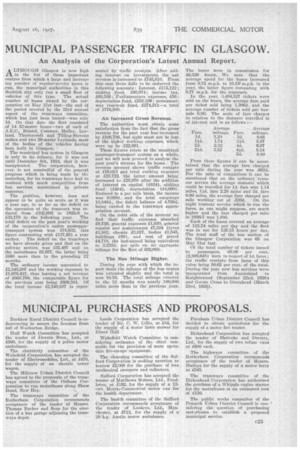MUNICIPAL PASSENGER TRAFFIC IN GLASGOW.
Page 47

If you've noticed an error in this article please click here to report it so we can fix it.
An Analysis of the Corporation's Latest Annual Report.
A LTHOUGH Glasgow is now high 13._ in the list of those important centres from which a large and increaslog number of regular-service buses is
• run, the municipal authorities in this Seottish city only run a small fleet of vehicles of this type. The actual number of buses owned by the corporation on May 31st last—the end of the period covered by the 83rd annual report of the tramways committee, which has just been issued—was only 16. On that date the fleet consisted of 14 32-seater buses—two of each of .A.E.C., Bristol, Commer, Halley, Leyland, Thornycroft and Tilling-Stevens makes and two 29-seater Leylands, most of the bodies of the vehicles having been built in Glasgow. • The municipal bus system in Glasgow is only in its infancy, for it was not until December 8th, 1924, that it was inaugurated. The corporation, however, is not unmindful of the general progress which is being made by the. motorbus, for its tramways have had to contend with much competition from bus services maintained b.v private concerns.
The position; however, does not appear to be quite so acute as it was a year ago, in so far as the deficit on the operation of the tramcars was reduced from 1102,992 in 1925-6 to /33,178 in the following year. The total deficit on the past year's working of the cerporation's entire passengertransport system was £78,632, this figure contrasting with 1137,851 a year earlier. The deficit On the tramways we have already giren and that on the subway section.. wag £35,497 and On the motorbuses £9,957, the latter being £660 more than in the preceding 12 mouths.
The ordinary income tau:taunted to 12,345,207 and the working expense's to 11,676,417, thus leaving a net revenue of £668,790, the comparable figure for the previous year being £609,581. Of the total income £2,340,837 is repre
sented by traffic receipts. After adding interest on investments, the net revenue is increased to .1743,810. From this sum there falls to be deducted the followiag amounts: Interest, £115,122; sinking fund, £60,974; income tax, £68,536; Parliamentary expenses, 186; depreciation fund, 1258,109; permanentway renewals fund, £274,211—a total of £776,988.
An Increased Gross Revenue.
The authorities most obtain some satisfaction from the fact that the gross
• revenue for the past year has increased by £106,786, but sight must not be lost of the higher working expenses, which were up by £22,891...
These figures relate to the municipal passenger-transport system as a whole, and we will now proceed to analyse the past year's returns for the buses. The revenue accountshows traffic receipts at £19,013 and total working expenses at £23,732, the latter amount being increased to £28,970 after the addition of interest on capital (1834), sinking fund (£404), depreciation (14,000). Reduced to a per mile basis, the Income was 9.0$8d. and the total outgoings 13.848d., the deficit balance of 4.760d. being carried to the tramways appropriation account.
On the debit side of the account we find that traffic expenses absorbed 19,759, general expenses 11,930, general repairs and maintenance £7,324 (tyres 1.1,883, chassis £3,827, bodies 11,545, buildings £69), and cost of petrol 14,718, the last-named being equivalent to 2.255d. Per mile on an aggregate mileage for the fleet of 502,088.
The Bus Mileage Higher.
During the year with which the report deals the mileage of the bus routes was extended slightly and the total is now 10.16. The total mileage cevered in the 12 months was nearly 100,000 miles more than in the previous Year.
The buses were in commission for 49,329 hours. We note that the. average speed for the buses increased from 9.75 m.p.h. to 10.1S mph. in the year, the latter figure comparing with 8.77 m.p.h. for the. tramcars.
In the year, 3,494,527 tickets were sold on the buses, the average fare paid per ticket sold being 1.306d. and the average number of tickets sold per busmile 6.96. The scale of fare charges inrelation to the distance travelled is of interest and is as follows :
Average Average Fare. mileage. Fare. mileage.
1d. . 1.20 3d. 4.68 lid. 1.74 31d. 5.87 2d. 2.32 4d. 6.97 24d. 3.52 43d, 8.14 5d.. 8.80 From these figures it can be ascertained that the average fare charged per mile during the year was .693d. For the sake of comparison it can be Mentioned that on the ordinary tramcar service the average distance which could be travelled for 1d. fare was 1.14 miles, 13-d. fare 2.28 miles and 2d. fare 9.96 miles, the average fare charged per mile working out at .3366. On the night tramcar service which is run the fares, as one might suppose, are much higher and the fare charged per mile in 1926-7 was 1.8(kl.
Each of the buses covered an average of 132.74 miles per day and the fleet was in use for 135.15 hours per day. The total staff of the bus section of the Glasgow Corporation was 65 on May 81st last.
Of the total number of tickets issued to passengers, 66.09 per cent. (2,309,645) were in respect of id. fares ; the traffic receipto from fares of this value being 50.62 per cent. of the total. During the year new bus' services were inaugurated from Anniesland to Knightswood (September 22nd, 1920 and Govan Cross to Greenhead (March 23rd, 1926).












































































































